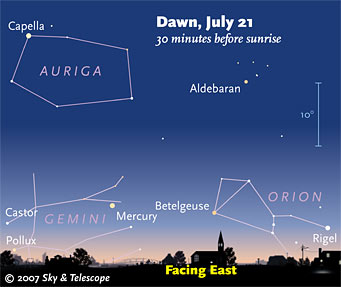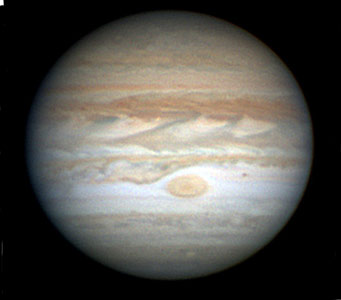Some daily events in the changing sky for July 13 – 21.

Getting up early? Mercury lies about a fist-width above the north-northeast horizon as the morning sky grows bright. The planet hangs in nearly the same spot for the remainder of July, but every morning the stars move a little farther up and to the right.
S&T Illustration
Friday, July 13
Saturday, July 14
Sunday, July 15
Monday, July 16
Tuesday, July 17
Wednesday, July 18
Thursday, July 19
Friday, July 20
Saturday, July 21

Face east after dusk, look up, and there's the big Summer Triangle, looking just like this only a lot bigger. Its bright white stars are Vega (top), Deneb (lower left), and Altair (lower right). Herve Dole shot this picture between saguaro cactuses in the southwest desert.
Alan MacRobert
Want to become a better amateur astronomer? Learn your way around the constellations. They're the key to locating everything fainter and deeper to hunt with binoculars or a telescope. For an easy-to-use constellation guide covering the whole evening sky, use the big monthly foldout map in each issue of Sky & Telescope, the essential magazine of astronomy. Or download our free Getting Started in Astronomy booklet (which only has bimonthly maps).
Once you get a telescope, to put it to good use you'll need a detailed, large-scale sky atlas (set of maps; the standard is Sky Atlas 2000.0) and good deep-sky guidebooks (such as Sky Atlas 2000.0 Companion or the enchanting though somewhat dated Burnham's Celestial Handbook). Read here how to use them most effectively.
More beginners' tips: "How to Start Right in Astronomy".
This Week's Planet Roundup
Mercury is low in the glow of dawn, brightening rapidly from magnitude +1.6 to +0.3 this week. Look for it above the east-northeast horizon about 60 minutes before sunrise. It's far lower right of Capella, and far lower left of Aldebaran. See article.
To find your local sunrise and sunset times, and much else, make sure you've put your location into our online almanac. If you're on daylight saving time, like most of North America, make sure the Daylight Saving Time box is checked.
Venus is bright at magnitude –4.7, but it's getting quite low in the west after sunset. Saturn and Regulus, much dimmer, are also in the vicinity. A telescope — or even steadily mounted binoculars — shows Venus to be a thin crescent!
Mars (magnitude +0.6, in Aries) rises after about 1 a.m. daylight saving time is and high in the east by dawn. Look for the Pleiades to its lower left, and Mars-like Aldebaran below the Pleiades. In a telescope, Mars is still just under 7 arcseconds wide. It's on its way to a Christmas-season opposition, when it will reach 16 arcseconds wide.

The Great Red Spot had crossed Jupiter's central meridian about 12 minutes earlier when Christopher Go took this image at 13:56 UT on July 2, 2007. The longitude (System II) on the central meridian was 128°.
Christopher Go
Jupiter (magnitude –2.5, in southern Ophiuchus) glares in the south during evening — you can't miss it. Antares, less bright, sparkles redly 5° below it; the two remain evening companions all summer. Other stars of Scorpius shine below them and to their right. In a telescope, Jupiter is a satisfying 43 arcseonds wide.
Saturn (magnitude +0.6) is sinking out of sight into the sunset glow, to the right of Venus. Binoculars will help. Don't confuse Saturn with twinkly Regulus closer to Venus.
Uranus (magnitude 5.8, in Aquarius) and Neptune (magnitude 7.8, in Capricornus) are well up in the southeast and south during early morning hours.
Pluto (magnitude 13.9, in the northwestern corner of Sagittarius) is highest in early evening, about 17° east of Jupiter. Finder charts for Uranus, Neptune, and Pluto are in the July Sky & Telescope, page 60.
All descriptions that relate to your horizon — including the words up, down, right, and left — are written for the world's midnorthern latitudes. Descriptions that also depend on longitude (mainly Moon positions) are for North America. Eastern Daylight Time (EDT) equals Universal Time (UT, UTC, or GMT) minus 4 hours.
To always get the up-to-date Sky at a Glance, bookmark this URL:
http://SkyTonight.com/observing/ataglance .
 0
0
Comments
You must be logged in to post a comment.